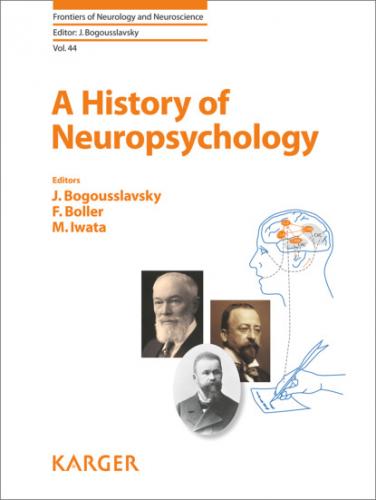References
1Marie P: Révision de la question de l’aphasie. La troisième circonvolution frontale gauche ne joue aucun role spécial dans la function du langage. Semeine Médicale du 23 mai 1906. (Marie P: Travaux et Memoires, Tome 1, Paris, Masson et Cie, 1926, pp 3–30).
2Marie P: Que fault-il penser des aphasies sous-corticales (apahsies pures)? Semaine Médicale du 17 octobre 1906. (Marie P: Travaux et Memoires, Tome 1, Paris, Masson et Cie, 1926, pp 31–64).
3Marie P: L’apahsie de 1861 á 1866. Essai de critique historique sur la génèse de la doctrine de Broca. Semaine Médicale du 28 novembre 1906. (Marie P: Travaux et Memoires, Tome 1, Paris, Masson et Cie, 1926, pp 65–92).
4Matsui T, Hirano A: An Atlas of the Human Brain for computerized Tomography. Tokyo-New York, Igaku-Shoin, 1978, p 153.
5Iwata M: CT anatomy of aphasia. Progress in CT 1884;6:133–137. (in Japanese)
6Iwata M: CT anatomy of the frontal lobe, especially in relation with language function. Seishin-Igaku 1895;27:619–624. (in Japanese)
7Bailey P: Pierre Marie (1853–1940); in Haymaker W, Schiller F (eds): The Founders of Neurology, ed 2. Springfield, IL, C. C Thomas, 1970, pp 476–479.
8Dejerine J: Anatomie des Centres Nerveux Tome 1. Paris, Rueff et Cie, 1895, pp 404–405.
Makoto Iwata
Tokyo Women’s Medical University
4-46-19, Hikawadai, Nerima-ku
Tokyo 179-0084 (Japan)
E-Mail iwata.makoto @ twmu.ac.jp
Bogousslavsky J, Boller F, Iwata M (eds): A History of Neuropsychology.
Front Neurol Neurosci. Basel, Karger, 2019, vol 44, pp 30–38 (DOI: 10.1159/000494950)
______________________
Gogi (Word Meaning) Aphasia and Its Relation with Semantic Dementia
Yamadori Atsushi
Tohoku University Graduate School of Medicine, Sendai, Japan
______________________
Abstract
In 1943, Tsuneo Imura, a neuropsychiatrist at Tokyo University, proposed a new aphasic syndrome and designated it as Gogi (word meaning) aphasia. According to Imura, it is characterized by (1) difficulty in comprehending spoken words despite good perception of sound, (2) disorders of expression due to loss of vocabulary and verbal paraphasia, (3) preserved ability of repetition, and (4) selective difficulty in reading and writing kanji (Japanese logographic character) with preserved ability of reading and writing kana (Japanese syllabic character). To be more specific, the difficulty in comprehending spoken words in Gogi aphasia is limited to substantive words as the name of the syndrome indicates, while comprehension of syntax remains unimpaired. Preserved repetition ability cannot be simply regarded as an automatic response, that is, echolalia, because the patient’s attitude in repeating was quizzical, picking up the particular word he did not comprehend. Imura vaguely attributed the responsible lesion to the second and third temporal gyri on the left side. Although the general pattern of the syndrome can be placed in the category of transcortical sensory aphasia, its uniqueness as the syndrome still stands out. Another uniqueness of the syndrome is its characteristic pattern of dissociated kanji-kana difficulty in reading and writing. This linguistic symptomatology observed in Gogi aphasia was first introduced to the western academic world on a German neuropsychiatric journal by Panse and Shimoyama in 1955. Ever since, the existence of Gogi aphasia as an independent syndrome among disorders of spoken language has gradually gained international recognition. But whether the pattern of the kanji-kana dissociation described by Imura is an integral part of the syndrome remains unsettled. A recently proposed concept of semantic dementia suggests symptomatic continuation of word meaning loss with non-linguistic semantic memory loss.
© 2019 S. Karger AG, Basel
In 1943 Tsuneo Imura, a neuropsychiatrist at Tokyo University, reported a new aphasic syndrome which he proposed to be called “Gogi aphasia” in an article published in Japanese [1]. “Go” of “gogi” means word, and “gi” means meaning. He admitted that the syndrome belongs to a broad category of transcortical sensory aphasia but claimed it has a unique characteristic and should be treated as a syndrome. The proposal remained unnoticed outside Japan until 1955 when Imura’s contribution to Japanese aphasiology was introduced along with his concept of “semantische Aphasie” in a German journal as a 2-part article by Panse and Shimoyama [2, 3]. The first part of this article was later translated into English [4]. In 1975, Sasanuma and Monoi [5] published a detailed linguistic study of a case with Gogi aphasia emphasizing the uniqueness of the syndrome because its symptomatology is inherently correlated with the complicated writing system of Japanese. In the article, Imura’s original concept of Gogi aphasia and its later impact on Japanese aphasiology were summarized briefly.
A Brief Introduction of the Japanese Script System
Since the symptom of Gogi aphasia is believed to be closely associated with a peculiar difficulty in reading and writing, a brief introduction of the Japanese script system might be necessary before describing the syndrome. In short, Japanese script is a hybrid of two different types of characters. Kan-ji was originally imported from China and literally means Han-letter. The Japanese applied these Han-letters to corresponding Japanese names with the similar concept as well as to Japanese syllables with similar Chinese sounds. This effort resulted in the complicated use of kanji for both names of concept and notification of pronunciation. Since Japanese system of syllables are quite different from Chinese, kana characters for Japanese syllables simplifying kanji form slowly developed. Kana has one letter-one syllable regularity, and the number is rather small, that is, 46. A kanji has multiple readings with no regularity. Also, its inventory is huge. For instance, the Japanese Government recommends using no more than 2,136 kanji in newspapers or laws to curb the kanji numbers in daily use. In usual Japanese script, semantic part is written by kanji and morphemic part (grammatical part) is written by kana.
The Syndrome of Gogi Aphasia
According to Imura, Gogi aphasia is characterized by 4 features [1]:
The first is difficulty in comprehending the meaning of a sentence spoken to. Although a typical patient could grasp the sound of the sentence correctly, he does not understand what they mean. He would repeat the sentence either automatically
